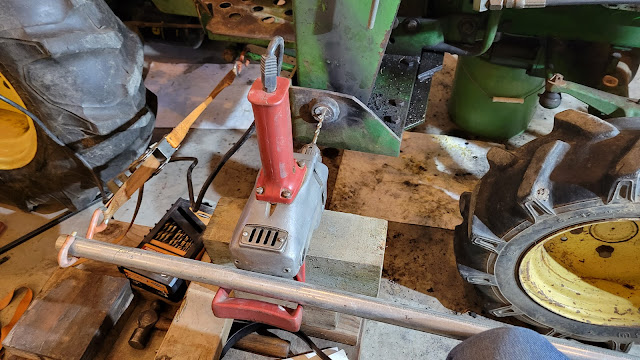Yes, I caved and decided to remove the loader (like the service manual says to do, and frankly is required since the front axle and frame come off for engine removal) before going further on engine removal. Removing a loader isn't usually something worthy of writing a blog posting about. It's usually a fairly simple task of removing four pins, unhooking four hydraulic lines, and hoisting the loader off with an engine hoist or something similar. My tractor unfortunately is not simple. Nope. Removing this loader is about as far from simple as you can get without falling off the edge of the earth. The reason? Someone must have lost the two rear bottom pins and decided to make some. Problem was, the pins were made too large for the bushing bores and Big Bubba knocked them in with a 12-pound sledge hammer, I'm guessing. This first photo below is one of the pins. After about an hour of trying to beat one of them out with a 3lb sledge hammer, judicious application of heat from an acetylene torch, and an 18-inch pipe wrench with 2-foot pipe on the end (and getting absolutely nowhere), I decided something drastic was necessary.
Enter Mr. Milwaukee and some hefty Chinese drill bits up to 1-inch in diameter. The first drill bit size I used (shown below) is 1/4-inch. I'll work my way up to the big dogs in steps. The drill motor is 6 amps at 120 volts, so 720 watts. Nearly 1 horsepower, and geared down to provide copious amounts of major torque. When a drill bit catches on something unexpectedly and you don't have a firm (did I say firm?) grip, something's gonna give, like your grip, your wrist bones, or possibly both. This next photo shows my setup for getting the hole drilled through the pin. I have a ratchet strap connected to the tractor, then a pipe through the outer eye of the strap. The pipe then goes behind the drill motor and I use the far end of the pipe to leverage the drill bit through the pin. It actually works quite well as long as you keep a firm grip on the drill handle. Smaller drill bits are pretty tame. It's when you get to the 7/8- and 1-inch drill bits that it starts to get interesting.
I had a few drill bit casualties. Nothing major but I had to straighten some of them when they'd catch while drilling. They were fairly easy to straighten, as the shanks of the Chinese bits weren't hardened at all.
This next photo shows what 10 hours worth of drilling, acetylene cutting, hammering, unsticking bits, etc. looks like. Yes, the loader is finally off the tractor. I'll obviously need to make new pins but I'll be sure to make them a slip fit. Glad that's over with. Now on to extracting the engine to fix the clutch issue.
Things sometimes went smoothly in this process, and other times they most certainly did not. I got a drill bit stuck 5 inches in and it wouldn't turn in either direction. I also couldn't pull it out. It was really jammed. That took 45 minutes to get out, mainly with the help of Vice Grips on the end and working it back and forth forever. It was things like that which just made the job torturous at times. The Chinese drill bits were also about 1/2-inch too short to drill completely through the pins, so I had to use a cutting torch to burn out the last little bit of the inner part of the pins.
After I'd drilled out the first pin as far as I could go, I figured maybe the pin would break in two if I used a drift and beat on the inner part to knock it inward and out the other side. The only thing I managed to do was to bend the 3/16-inch thick inner flange that the inner bushing seemed to be welded into. The pin was so tight in the bushing that it did not budge. The pin did split like I figured it would, as there wasn't much remaining of it after drilling, but it just ended up bending the inner flange.
Here are a couple more photos of the remnants of the pins. After getting the loader frame off, I had to use the cutting torch to burn out a chunk of one pin still in the frame.
This next photo shows the remains of both pins.










No comments:
Post a Comment